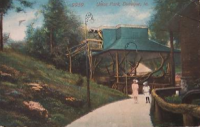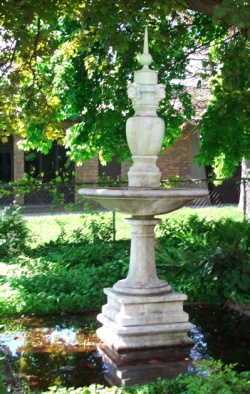Encyclopedia Dubuque
"Encyclopedia Dubuque is the online authority for all things Dubuque, written by the people who know the city best.”
Marshall Cohen—researcher and producer, CNN
Affiliated with the Local History Network of the State Historical Society of Iowa, and the Iowa Museum Association.
UNION PARK
UNION PARK. Former popular park northwest of the city of Dubuque. The Dubuque Electric Railway Light and Power Company, known locally as the Allen and Swiney Motor Line Company, purchased forty acres of land from the farm of William G. STEWART on March 6, 1891. The company owners, new to the community, desired a way to publicize the use of electricity, a means of transportation they used with trolleys around the city with only limited success. The idea of a park at the end of their trolley line promised to give them the needed publicity.
Construction of the line preceded the building of trails and pathways on the park property. The name Allen and Swiney chose for their completed project was "Stewart Park," in honor of William G. Stewart. Other accounts suggest the park was named in honor of MAYOR Robert W. Stewart.
On April 24, 1891, a fee of ten cents delivered the first visitors by trolley to the natural enchantments of Stewart Park, snuggled in Horseshoe Hollow. The return trip cost fifteen cents. The park officially opened on April 26, 1891. On April 27 work began on a dance pavilion and refreshment booth. Other buildings planned for the grounds included a small pavilion for parties, a bowling alley, and living quarters for park employees.
Money soon became an impossible obstacle for the park's owners. Sidewalks were rare, a theater planned for the grounds became a second-class dance hall, and the bowling alley proved less than ideal.
Unable to operate a trolley line and a park, Allen and Swiney sold out to the Old Colony Trust Company on May 11, 1893. As a result of a series of legal actions ending on July 7, 1899, the ownership of the property became part of the General Electric Company. General Electric reorganized the local firm into the Home Electric Company that sold out to UNION ELECTRIC COMPANY. L. D. Mathes was chosen to become the first park manager.
In the first of many changes, the park was renamed Union Park, honoring the names of the new owners. New track was laid out to the park. The dance hall was remodeled with the addition of large porches, and bowling alleys were equipped with new balls and pins. The replacement of incandescent lamps with new lights powered through wires strung from the Shooting Park cost Union Electric an estimated five hundred dollars.
In 1904 dirt trails and paths were replaced with cement sidewalks that ran from the loading platform to all the buildings. The construction of a new dance hall, known as "The Pavilion," was a major event. Visitors to the park were also impressed when the loading platform, little more than a dock, was replaced by an elaborate shelter that protected visitors from bad weather.
In 1905 a unique bandstand made of gnarled tree branches was constructed across from "The Pavilion." A second bandstand of the same design was built in 1907 farther into the valley with hundreds of benches nearby. Grand concerts from this bandstand were held on a regular basis each week. Newspaper accounts from the time tell of the bands and orchestras being paid from $2,500 to $5,000 weekly. The bandstand was also the setting for many high school and college graduations.
More land was purchased in 1908, and a children's playground was developed with every type of equipment including slides, swings and carousels. A roller coaster made of wood was generally thought too "rickety" by parents who kept their children away. The jerky ride often sent straw hats flying-into a fishpond. Steamy August days were momentarily defeated by a casual walk through a cave discovered in 1900 and modernized in 1908 with the addition of a walkway and electric lights.
The year 1909 witnessed the development of the Mammoth Theater, advertised as the largest in the West. Costing Union Electric $30,000 to construct, Mammoth Theater stretched from one hillside to the other dividing the park into two parts. Planning for large crowds, 1,500 opera chairs were installed. The theater, planned carefully for excellent acoustics, was open at one end, allowing an additional 5,000 people to see and hear (at no charge) programs by such musicians as Guy Lombardo.
Depending on the program and time of day, sitting in the opera seats cost audience members ten to fifteen cents. Benches set up behind the opera seats cost five to ten cents. A children's wading pool, constructed as a miniature of the internationally known one in Chicago's Ogdon Park, was a park addition in 1910.
Park use flourished between 1911 and 1919. In 1916 Union Electric Company assets were sold to the Dubuque Electric Company, but continued attention to beautifying the area led the park to remain one of eastern Iowa's most enchanting settings.
On July 9, 1919, weather predictions called for the possibility of thunderstorms in the afternoon, but usual summer activities were continued as planned. The first drops of rain in the afternoon quickly turned into a downpour. Picnickers, still feeling secure, ran for nearby shelter unaware that the cloudburst had created a wall of water that soon tore into the park. Concrete sidewalks were ripped up by the fury of the torrent that demolished the merry-go-round and backed up behind the theater to a height estimated to be twenty feet before pushing on downhill.
Five people died, and an estimated fifteen thousand dollars in damage was done. News of the destruction was so important to the citizens of Dubuque that the announcement of the presentation of the peace treaty by President Wilson was crowded into the lower left hand comer of the front page of the newspaper.
The effort to put Union Park back together began almost immediately. Many buildings-the roller coaster, fishpond, and several fountains were rebuilt to look like they had before the flood. A new dance pavilion and theater were planned. Of concern to Dubuque Electric Company, the park owners, was the appearance of automobiles in Dubuque. These vehicles permitted Dubuque residents, once confined to Dubuque and its attractions, to travel out of the city. Union Park also suffered from the opening, in 1907, of EAGLE POINT PARK.
To compete with Eagle Point and attractions in other cities, a new theater was planned for the park. Aware that the old theater, stretched across the valley, had blocked the water and made the flood worse, designers planned a long rather than a very wide building. The cost of this design proved too expensive, and in place of a new theater, the old theater was reopened as a dance pavilion with the floor from the Mammoth Theater. This ballroom, advertised as the largest in Iowa, opened on July 26, 1923.
The same year a swimming pool, said to be able to hold 2,000 bathers, was constructed to attract residents back to the park. The popular "Pavilion" was converted into a roller-rink.
All efforts to rekindle interest in Union Park failed as attendance remained low. On April 27, 1927, Dubuque Electric Company sold out to INTERSTATE POWER COMPANY. In 1934 Interstate Power announced that Union Park would close.
In 1935 the park buildings were dismantled. One of the two statues that stood in front of the old Pavilion ended up in the yard outside the Ryan House restaurant. The other graced the patio of the former home of Joseph A. RHOMBERG. Union Park's dance hall was reassembled as the popular MELODY MILL on Sageville Road near the intersection of Highway 52 and John F. Kennedy Road. For safety, the cave entrance was blasted shut. Wood from the roller coaster was made into a barn.
On September 5,1946, the YOUNG MEN'S CHRISTIAN ASSOCIATION (Y.M.C.A.) and the BOY SCOUTS purchased the land. Cabins were constructed on the hillsides along with a mess hall, swimming pool, stables, and bathrooms. Soon after the completion of the project, the Scouts chose to erect their own campgrounds leaving the Y.M.C.A. with the Union Park property.
Union Park Camp was used as a residence camp until 1983. It was thereafter used annually by over five hundred children as a day camp. The Men's Club of the Y.M.C.A. has used funds from their Christmas tree sales and the annual lemonade stand at the County Fair to make improvements. Boy Scouts have also used the camp for projects. (Photos Courtesy: http://www.dubuquepostcards.com)


























